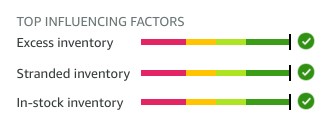Back to Page
Amazon SEO
Inventory Performance Index: Everything Amazon Sellers Need To Know
Inventory Performance Index: Everything Amazon Sellers Need To Know


Back to Page
Amazon SEO
Inventory Performance Index: Everything Amazon Sellers Need To Know

One area that Amazon sellers are not great at is inventory management. With the fluctuating demands and ever-increasing competition, it becomes challenging to strike the right balance between product demand and supply. Inefficient inventory management can prove to be a constant stumbling block to your flourishing Amazon business because Amazon likes to sell products, not stock them. The retail giant has already increased the Amazon FBA storage fees and now, in order to resolve the overcapacity issues in the fulfillment centers, it has reinforced new charges called Inventory Performance Index.
What is the Inventory Performance Index?
Inventory Performance Index (IPI) is a metric used by Amazon which will penalize the FBA sellers for their slow-moving inventory. This brightly colored bar is measured with a score ranging from 0 to 1000. It will bucket sellers in two different groups – those who have a score above 350 and those who have a score below 350. A score below 350 indicates that there are issues you should take action for while a score above 400 indicates that your business is performing well.
Sellers with low score will have limited storage access and sellers with high score will have unlimited storage space for standard size and oversized items. Score well in this metric and you will be rewarded by getting unlimited storage!

Factors Affecting Inventory Performance Index:
Your IPI is directly impacted by excess inventory, sell-through rate and stranded inventory. On your seller central dashboard, each of these factors is assigned a colored bar that determines its performance.

● Excess Inventory:
Excess inventory helps the seller to determine whether to stock or remove the inventory from FBA. It is the number of units for which the cost of holding the inventory in storage is more than the cost of taking action to move them (such as reducing the price to remove excess units or increase sell-through).
● In-stock Inventory:
It is the percentage of time your replenishable FBA ASINs have been in stock in the last 30 days. Furthermore, it is valued by the quantity of units that have been sold in the past 60 days. Amazon provides recommendations on what items to restock and when. While maintaining a stock of fast-moving items can help increase the seller’s IPI, there is no penalty for restocking a discounted or non-replenishable item.
● Stranded Inventory:
A product is tagged as stranded when it is in stock at Amazon’s fulfillment centers but is not available for purchasing because your listing does not meet Amazon’s guidelines. Your product is unable to move but still is applicable for incurring FBA storage fees.
How to Maintain Your Inventory Performance Index?
As the algorithm used to calculate IPI is not yet disclosed by Amazon, the best way to stay in the right end of the score is by monitoring and optimizing your excess inventory, stranded inventory, and sell-through rate. You can follow the below suggestions to rank well on your IPI score:
Stay proactive and monitor your Inventory Performance Index regularly
Fix stranded inventory immediately to ensure that your inventory is always available for purchase
Sell through any of the slow-moving, unprofitable, and excess inventory
Stay in stock for the active and high-selling ASINs
Develop a strategy to forecast your inventory needs
Consider third-party assistance for inventory management
This inventory adjusting move has been taken to discourage the seller from stocking up the inventory in fulfillment centers. You will have to view Amazon Warehouses as fulfillment centers and not your personal storage space. Efficient inventory management is directly proportional to an increase in your IPI score so make sure you regularly monitor your inventory and Amazon dashboard.
If you don't have expertise or lack of time then consider expert guidance from a reputed firm that provides Amazon SEO or Amazon consulting services.
One area that Amazon sellers are not great at is inventory management. With the fluctuating demands and ever-increasing competition, it becomes challenging to strike the right balance between product demand and supply. Inefficient inventory management can prove to be a constant stumbling block to your flourishing Amazon business because Amazon likes to sell products, not stock them. The retail giant has already increased the Amazon FBA storage fees and now, in order to resolve the overcapacity issues in the fulfillment centers, it has reinforced new charges called Inventory Performance Index.
What is the Inventory Performance Index?
Inventory Performance Index (IPI) is a metric used by Amazon which will penalize the FBA sellers for their slow-moving inventory. This brightly colored bar is measured with a score ranging from 0 to 1000. It will bucket sellers in two different groups – those who have a score above 350 and those who have a score below 350. A score below 350 indicates that there are issues you should take action for while a score above 400 indicates that your business is performing well.
Sellers with low score will have limited storage access and sellers with high score will have unlimited storage space for standard size and oversized items. Score well in this metric and you will be rewarded by getting unlimited storage!

Factors Affecting Inventory Performance Index:
Your IPI is directly impacted by excess inventory, sell-through rate and stranded inventory. On your seller central dashboard, each of these factors is assigned a colored bar that determines its performance.

● Excess Inventory:
Excess inventory helps the seller to determine whether to stock or remove the inventory from FBA. It is the number of units for which the cost of holding the inventory in storage is more than the cost of taking action to move them (such as reducing the price to remove excess units or increase sell-through).
● In-stock Inventory:
It is the percentage of time your replenishable FBA ASINs have been in stock in the last 30 days. Furthermore, it is valued by the quantity of units that have been sold in the past 60 days. Amazon provides recommendations on what items to restock and when. While maintaining a stock of fast-moving items can help increase the seller’s IPI, there is no penalty for restocking a discounted or non-replenishable item.
● Stranded Inventory:
A product is tagged as stranded when it is in stock at Amazon’s fulfillment centers but is not available for purchasing because your listing does not meet Amazon’s guidelines. Your product is unable to move but still is applicable for incurring FBA storage fees.
How to Maintain Your Inventory Performance Index?
As the algorithm used to calculate IPI is not yet disclosed by Amazon, the best way to stay in the right end of the score is by monitoring and optimizing your excess inventory, stranded inventory, and sell-through rate. You can follow the below suggestions to rank well on your IPI score:
Stay proactive and monitor your Inventory Performance Index regularly
Fix stranded inventory immediately to ensure that your inventory is always available for purchase
Sell through any of the slow-moving, unprofitable, and excess inventory
Stay in stock for the active and high-selling ASINs
Develop a strategy to forecast your inventory needs
Consider third-party assistance for inventory management
This inventory adjusting move has been taken to discourage the seller from stocking up the inventory in fulfillment centers. You will have to view Amazon Warehouses as fulfillment centers and not your personal storage space. Efficient inventory management is directly proportional to an increase in your IPI score so make sure you regularly monitor your inventory and Amazon dashboard.
If you don't have expertise or lack of time then consider expert guidance from a reputed firm that provides Amazon SEO or Amazon consulting services.
One area that Amazon sellers are not great at is inventory management. With the fluctuating demands and ever-increasing competition, it becomes challenging to strike the right balance between product demand and supply. Inefficient inventory management can prove to be a constant stumbling block to your flourishing Amazon business because Amazon likes to sell products, not stock them. The retail giant has already increased the Amazon FBA storage fees and now, in order to resolve the overcapacity issues in the fulfillment centers, it has reinforced new charges called Inventory Performance Index.
What is the Inventory Performance Index?
Inventory Performance Index (IPI) is a metric used by Amazon which will penalize the FBA sellers for their slow-moving inventory. This brightly colored bar is measured with a score ranging from 0 to 1000. It will bucket sellers in two different groups – those who have a score above 350 and those who have a score below 350. A score below 350 indicates that there are issues you should take action for while a score above 400 indicates that your business is performing well.
Sellers with low score will have limited storage access and sellers with high score will have unlimited storage space for standard size and oversized items. Score well in this metric and you will be rewarded by getting unlimited storage!

Factors Affecting Inventory Performance Index:
Your IPI is directly impacted by excess inventory, sell-through rate and stranded inventory. On your seller central dashboard, each of these factors is assigned a colored bar that determines its performance.

● Excess Inventory:
Excess inventory helps the seller to determine whether to stock or remove the inventory from FBA. It is the number of units for which the cost of holding the inventory in storage is more than the cost of taking action to move them (such as reducing the price to remove excess units or increase sell-through).
● In-stock Inventory:
It is the percentage of time your replenishable FBA ASINs have been in stock in the last 30 days. Furthermore, it is valued by the quantity of units that have been sold in the past 60 days. Amazon provides recommendations on what items to restock and when. While maintaining a stock of fast-moving items can help increase the seller’s IPI, there is no penalty for restocking a discounted or non-replenishable item.
● Stranded Inventory:
A product is tagged as stranded when it is in stock at Amazon’s fulfillment centers but is not available for purchasing because your listing does not meet Amazon’s guidelines. Your product is unable to move but still is applicable for incurring FBA storage fees.
How to Maintain Your Inventory Performance Index?
As the algorithm used to calculate IPI is not yet disclosed by Amazon, the best way to stay in the right end of the score is by monitoring and optimizing your excess inventory, stranded inventory, and sell-through rate. You can follow the below suggestions to rank well on your IPI score:
Stay proactive and monitor your Inventory Performance Index regularly
Fix stranded inventory immediately to ensure that your inventory is always available for purchase
Sell through any of the slow-moving, unprofitable, and excess inventory
Stay in stock for the active and high-selling ASINs
Develop a strategy to forecast your inventory needs
Consider third-party assistance for inventory management
This inventory adjusting move has been taken to discourage the seller from stocking up the inventory in fulfillment centers. You will have to view Amazon Warehouses as fulfillment centers and not your personal storage space. Efficient inventory management is directly proportional to an increase in your IPI score so make sure you regularly monitor your inventory and Amazon dashboard.
If you don't have expertise or lack of time then consider expert guidance from a reputed firm that provides Amazon SEO or Amazon consulting services.






